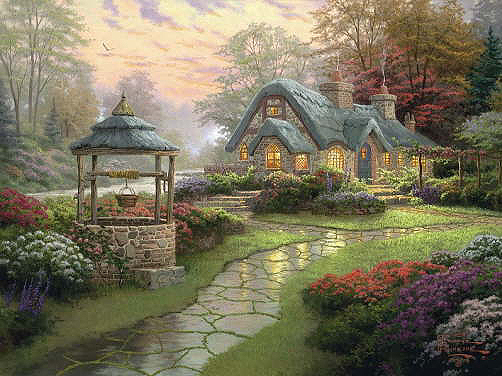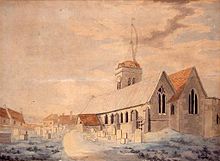On Friday April 6th, famous “painter of light” Thomas Kinkade died. Kinkade is known not only for his beautifully cheerful paintings but his strong faith and belief in Christianity. Within many of his paintings, he hid the names of his family members as well as Christian messages and symbolism such as the fish that he painted under his every signature. His nickname, “painter of light,” is likely a reference to the Renaissance; the era where the techniques of point of view and specifically light and shadow depiction were technically developed and perfected. In this era, the technique chiaroscuro was born. Chiaroscuro is a technique that utilizes light and dark shades and shadows to create realistic depth through usage of these various contrasting tonalities. The discovery of this way of painting light and shadow was drastic in comparison to the Byzantine style used throughout the middle ages.
The representation of “God” through use of light is seen in some Renaissance paintings; a homage that Kinkade brought from this era and to his modern works of art. This is by far the biggest similarity between Kinkade’s work and Renaissance paintings. Though he enjoyed the title “painter of light,” I do not think Kinkade quite measures up to Rembrant, the artist formally known as the “Painter of Light and Shadow.” His work more closely aligns with another famous “painter of light” from the Romantic Movement, Joseph Mallord William Turner. While Rembrandt is considered one of the most influential European artists of all time and Turner is credited for redefining modern landscape painting, Kinkade will surely have a place in art history but not for redefining or advancing art aesthetically as these aforementioned masters had.
Thomas Kinkade was one of the top grossing commercial artists of all time. He brought art into the homes of millions, many of whom could not afford to buy originals. His line of products varied as much as their price range and spanned from various collectables, post cards books, and jig saw puzzles all the way to original oil paintings; thus making it easy for people of all income brackets to afford.
Because of the wide ranging commercialism and sunny disposition of Kinkade’s artwork, some people thought of his work as nothing more than kitsch. The opinion that his work was superficial and lacked depth came mostly from art critics and members of the “art community.” It seems a bit snobbish to be offended by Kinkade’s artwork on the merit of its wide-ranging availability and the interest that regular folks took in it. It was art that everyone could purchase and enjoy. His talent is indisputable and obvious from his technical application of paint alone, his use of light, shadow and perspective.
Kitsch n
1. sentimentality, tastelessness or ostentation in any of the arts
2. collectively, decorative items that are regarded as tasteless, sentimental, or ostentatious in style
Well his paintings do have a delightfully sentimental feel to them… so perhaps in that sense they are a bit kitschy, but does that really make them less artsy than more serious pieces? What makes great art?
Who could forget Marcel Duchamp’s “Fountain” in the 1917 Armory Show? Mind baffling and controversial at the time (and even now, perhaps), “Fountain” provided an edge not seen in Kinkade’s work. Aren’t both Duchamp’s “Fountain” and Kinkade’s works considered art despite their obvious differences? It really depends on your perspective and the way you evaluate things. I always graded my liking for a piece of artwork by how it made me feel. Whether it was a film, painting or song, how it made me feel either provided me with an inherit emotion that I either did or did not want to align myself with at the time of the viewing or afterwards. For example, I hate the movie “Fargo.” Although everyone else I know loves it, I consider this a “feel bad” movie and refuse to watch it when it’s on. Though I do not like it, I do recognize the film’s artistic value. The movie is very dark and humorous to some. I know that it could easily be seen as “artsy.”
I always liked Kinkade’s artwork. The only Kinkade stuff I ever bought was the yearly “Post Card of the Week” postcard book he came out with every year. Some of them I’d send to friends, some of them I would cut into pieces and make new art out of it, and some of the post card books I kept in tact because just flipping through them was fun and mellowed me out. I particularly loved his cottages. Perhaps it is because I love fairy tales and the cottages reminded me of what I picture Snow White or Little Red Riding Hood’s grandmother’s house would look like. I also imagined that his inspiration for these cottages came from deep within the woods of Germany’s Black Forest or some other European landscape. I was wrong.
One of the first places where Kinkade sold his work was at the Cottage Gallery in Carmel, California. The town of Carmel, nicknamed “Carmel by the Sea,” is a beautiful coastal village made up entirely of the quaint European inspired cottages seen in much of Kinkade’s artwork! The community is very artsy and at one point in time, almost 60% of the residents were working artisans of some sort. It is an art community in which none of the cottages have street numbers but individual names and because of this, residents must pick up their mail from a central location in the center of town.
The homes at Carmel by the Sea are not all cottages. The real estate is prime and on average, the value of a home is around one million dollars, so for most people the serenity and beauty in Kinkade’s artwork is the closest they will ever get to one of these gorgeous sea side cottages.
Though Kinkade’s legacy in his artwork will be remembered as cheerful and happy, things for the man behind the canvas were not always so great. Behind his beautiful artwork was an artist who was emotionally tormented like many others in his field. It is well known that Kinkade had an ongoing battle with alcoholism, however; despite the inner pain and torment his battle with addiction brought him and his family, he was able to bring joy to many others through his work. He is quoted as saying many times that through his art, he “just wanted to make people happy.” His stance is selfless and though he may not go down in history as a Da Vinci or a Botticelli, or even as the official “painter of light,” he will go down as “the People’s Painter,” the man who brought art to the masses and art appreciation to those who didn’t even know they appreciated it.










I loved your perspective on Kinkade and I learned so much from reading it. The Carmel California connection makes sense. I wonder at that opulence however. I wonder at what it has brought us to. I see the wealth of the world squandered somehow. Like the Painters of Light in our history books they and Kinkade represented a pinnacle of the light. So I sense some sort of decline. I see that that light in Kinkade’s cottages becomes a flame and has a creepy quality to it. It does not seem completely divine to me. That people loved it and had access to it makes me even more suspect. The masses have a strong pull as a group. It takes courage to go against the people.
I am glad I did not drink the Kinkade cool aide. I tried to recreate a Kinkade house on our dry erase board at work. It was fun to put the glow in the windows. Holy light. I see it and I know that art is about following that light. I am not a Christian so I think of the light differently that a guide to heaven. I wonder that Kinkade did not have light inside him. I know how alcohol can look like light but is really darkness.
“Kinkade cool aid” lol
I really did make paragraphs in that comment. lol They disappeared!
I just don’t see the “Creepiness” lol- it is interesting that you do- like it’s too happy or something? Like Disney World??
I sold a lot of his stuff (DVDS) etc. Not a huge fan but had great respect for him.
The light got me all the time though. I understood.
HUGGGGGGGGGGGGG
i liked a lot of his work but could see some of the critics points that after awhile things in the painting were just too perfect and sentimental. you look at the pictures and think how great it would be to live in a place like that but as George Clooney’s character says in the film “The Descendants” people think if you live in Hawaii you have no problems. like we have no unemployment or cancer patients here are different than those anywhere else. i do hope Mr. Kinkade rests in peace and condolences for the family. if you want a take on another popular painter who was over looked by critics in his life but has since gained respect watch the DVD “Norman Rockwell: Painting America” it’s very good.
“people think if you live in Hawaii you have no problems. ” wow that’s a great quote- some did compare him to Rockwell- though I think they are completely different not because of their individual styles but in what they did… I did not realize Rockwell was unpopular
Rockwell was never popular with the majority of the art establishment though the majority of the populace did embrace him and he did have supporters among some artists. the DVD is very informative.
This was interesting because I don’t know anything about painting. I liked his paintings, liked how warm and cozy the homes looked in winter and the beautiful colors of flowers in summer. They seemed safe and inviting.
Like you I love that fairy tale aspect. I always wanted to live in a house growing up so they have that feel of somewhere safe, like a home. I love paintings of women holding children because I wanted my mom to hold me. I adore the softfaces on Maxfield Parrish’s women. I’m attracted to things I wanted that feel joyful.
Some paintings are dark and scary, life is already like that so I don’t like to look at it. Maybe some people didn’t have dark scary things in their life so it intrigues them, or maybe their lives were like that and it feels familiar.
The fountain makes me think of cleaning the bathroom, I’ve been too close to the toilet often enough to not want to look at one. Art makes me feel things, I want to feel good as much as possible. Kincade’s paintings made me feel good, it’s that simple for me.
Thanks for your comment- I think we share similar feelings towards art
I am certainly not an art snob. My favorite personal piece is made completely of glitter. I don’t even have a problem with the fact that he, or his corporation, churned out thousands of giclees, hand embellished in factories by non-artists. The problem that I have with Mr. Kinkade, is that he fleeced hundreds of people out of their life savings with lies and manipulations JUST TO MAKE MORE MONEY. I am sorry for his family but they will never have to worry about the loss of their retirement nest egg like many will because of his false promises. Possibly Mr. Kinkade sought relief from guilt through the bottle.